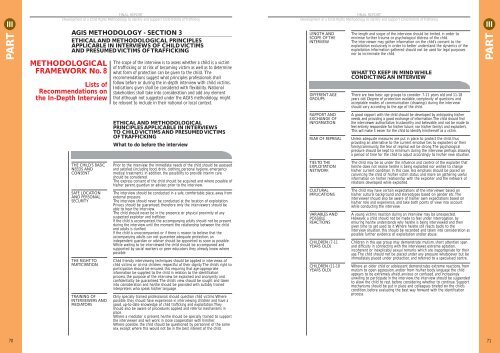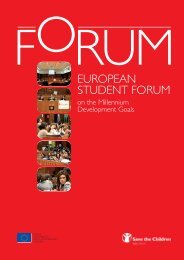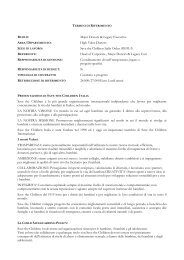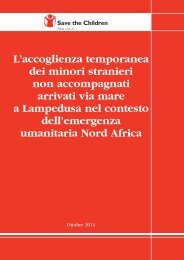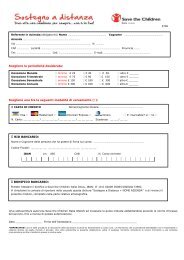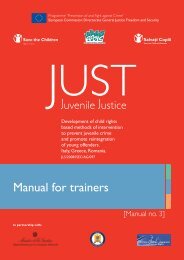FINAL REPORT - Save the Children Italia Onlus
FINAL REPORT - Save the Children Italia Onlus
FINAL REPORT - Save the Children Italia Onlus
You also want an ePaper? Increase the reach of your titles
YUMPU automatically turns print PDFs into web optimized ePapers that Google loves.
IIIPART<strong>FINAL</strong> <strong>REPORT</strong>Development of a Child Rights Methodology to Identify and Support Child Victims of TraffickingMETHODOLOGICALFRAMEWORK No. 8AGIS METHODOLOGY - SECTION 3ETHICAL AND METHODOLOGICAL PRINCIPLESAPPLICABLE IN INTERVIEWS OF CHILD VICTIMSAND PRESUMED VICTIMS OF TRAFFICKINGLists ofRecommendations on<strong>the</strong> In-Depth InterviewThe scope of <strong>the</strong> interview is to assess whe<strong>the</strong>r a child is a victimof trafficking or at risk of becoming victim as well as to determinewhat form of protection can be given to <strong>the</strong> child. Therecommendations suggest what principles professionals shallfollow before or during <strong>the</strong> in-depth interview with child victims.Indications given shall be considered with flexibility. Nationalstakeholders shall take into consideration and add any elementthat although not suggested under <strong>the</strong> AGIS methodology, mightbe relevant to include in <strong>the</strong>ir national or local context.<strong>FINAL</strong> <strong>REPORT</strong>Development of a Child Rights Methodology to Identify and Support Child Victims of TraffickingLENGTH ANDSCOPE OF THEINTERVIEWDIFFERENT AGEGROUPSThe length and scope of <strong>the</strong> interview should be limited, in order tominimise fur<strong>the</strong>r trauma or psychological distress of <strong>the</strong> child.The interviewer may ga<strong>the</strong>r information on <strong>the</strong> child’s consent to <strong>the</strong>exploitation exclusively in order to better understand <strong>the</strong> dynamics of <strong>the</strong>exploitation. Information ga<strong>the</strong>red should not be used for legal purposesnor to incriminate <strong>the</strong> child.WHAT TO KEEP IN MIND WHILECONDICTING AN INTERVIEWThere are two basic age groups to consider: 7-11 years old and 11-18years old. Degree of protection available, complexity of questions andacceptable modes of communication (drawings) during <strong>the</strong> interviewshould vary according to <strong>the</strong> age of <strong>the</strong> child.IIIPARTETHICAL AND METHODOLOGICALPRINCIPLES APPLICABLE IN INTERVIEWSTO CHILD VICTIMS AND PRESUMED VICTIMSOF TRAFFICKINGWhat to do before <strong>the</strong> interviewRAPPORT ANDEXCHANGE OFINFORMATIONFEAR OF REPRISALA good rapport with <strong>the</strong> child should be developed by anticipating his/herneeds, and providing a good exchange of information.The child should find<strong>the</strong> interviewer authoritative, trustworthy and believable, and not be made tofeel entirely responsible for his/her future, nor his/her family’s and exploiter’s.This will make it easier for <strong>the</strong> child to identify him/herself as a victim.Unless adequate measures are put in place to protect <strong>the</strong> child, thusproviding an alternative to <strong>the</strong> current emotive ties to exploiters or <strong>the</strong>irfamily/community, <strong>the</strong> fear of reprisal will be strong.The psychologicalpressure should be kept to minimum during <strong>the</strong> interview, perhaps allowinga period of time for <strong>the</strong> child to adjust accordingly to his/her new situation.THE CHILD’S BASICNEEDS ANDCONSENTSAFE LOCATIONAND PERSONALSECURITYTHE RIGHT TOPARTICIPATIONTRAINING OFINTERVIEWERS ANDMEDIATORSPrior to <strong>the</strong> interview, <strong>the</strong> immediate needs of <strong>the</strong> child should be assessedand satisfied (including food, drink, clothing, personal hygiene, emergencymedical treatment). In addition, <strong>the</strong> possibility to provide interim careshould be considered.The express consent of <strong>the</strong> child should be acquired and where possible ofhis/her parent, guardian or adviser, prior to <strong>the</strong> interview.The interview should be conducted in a safe, comfortable place, away fromexternal pressure.The interview should never be conducted at <strong>the</strong> location of exploitation.Privacy should be guaranteed, <strong>the</strong>refore only <strong>the</strong> interviewers should beable to hear <strong>the</strong> interview.The child should never be in <strong>the</strong> presence or physical proximity of anysuspected exploiter and trafficker.If <strong>the</strong> child is accompanied, <strong>the</strong> accompanying adults should not be presentduring <strong>the</strong> interview until <strong>the</strong> moment <strong>the</strong> relationship between <strong>the</strong> childand adults is clarified.If <strong>the</strong> child is unaccompanied, or if <strong>the</strong>re is reason to believe that <strong>the</strong>accompanying adults can not guarantee adequate protection, anindependent guardian or adviser should be appointed as soon as possible.While waiting to be interviewed <strong>the</strong> child should be accompanied andsupported by social workers or peer educators <strong>the</strong>y already know wherepossible.Child friendly interviewing techniques should be applied in interviews ofchild victims or at-risk children, respectful of <strong>the</strong>ir dignity.The child’s right toparticipation should be ensured, this requiring that age-appropriateinformation be supplied to <strong>the</strong> child in relation to <strong>the</strong> identificationprocess, <strong>the</strong> purpose of <strong>the</strong> interview be explained and anonymity andconfidentiality be guaranteed.The child’s view should be sought and takeninto consideration and he/she should be provided with suitably trainedinterpreters who speak his/her language.Only specially trained professionals should question child victims. Wherepossible, <strong>the</strong>y should have experience in interviewing children and have agood, up-to-date knowledge of child trafficking and exploitation.Theyshould also be aware of procedures applied and referral mechanisms inplace.Where a mediator is present, he/she should be specially trained to support<strong>the</strong> interviewer and will work in close cooperation with him/her.Where possible, <strong>the</strong> child should be questioned by personnel of <strong>the</strong> samesex, except where this would not be in <strong>the</strong> best interest of <strong>the</strong> child.TIES TO THEEXPLOITATIONNETWORKCULTURALIMPLICATIONSVARIABLES ANDPOSSIBLEREACTIONSCHILDREN (7-11YEARS OLD)CHILDREN (11-18YEARS OLD)The child may be so under <strong>the</strong> influence and control of <strong>the</strong> exploiter tha<strong>the</strong>/she does not realise he/she is being exploited nor wishes to changehis/her current condition. In this case, less emphasis should be placed onconvincing <strong>the</strong> child of his/her victim status, and more on ga<strong>the</strong>ring usefulinformation on his/her relationship with <strong>the</strong> exploiter and <strong>the</strong> network ofrelations developed while exploited.The child may have certain expectations of <strong>the</strong> interviewer based onhis/her cultural background and stereotypes based on gender etc.Theinterviewer should also be aware of his/her own expectations based onhis/her role and experience, and take both points of view into accountwhile conducting <strong>the</strong> interview.A young victim’s reaction during an interview may be unexpected.However, a child should not be made to feel under interrogation, byensuring he/she understands why he/she is being interviewed and <strong>the</strong>ngiven time to get used to it. Where he/she still reacts badly to <strong>the</strong>interview situation, this should be recorded and taken into consideration aspossible fur<strong>the</strong>r evidence of exploitation and/or abuse.<strong>Children</strong> in this age group may demonstrate: mutism, short attention spanand difficulty in connecting with <strong>the</strong> interviewer, extreme agitation,incoherent or inexplicably sexual remarks which are inappropriate for <strong>the</strong>irage.The child should not be placed under any pressure whatsoever but beimmediately placed under protection, and referred to a specialised centre.Where an older child or adolescent demonstrates extreme reactions, frommutism to open aggression, and/or from his/her body language <strong>the</strong> childappears to be extremely afraid, anxious or confused, and increasinglyunwilling to participate in <strong>the</strong> interview, <strong>the</strong> interview should be suspendedto allow <strong>the</strong> child to rest, before considering whe<strong>the</strong>r to continue. Supportmechanisms should be put in place and colleagues briefed on <strong>the</strong> child’scondition, before evaluating <strong>the</strong> best way forward with <strong>the</strong> identificationprocess.7071


